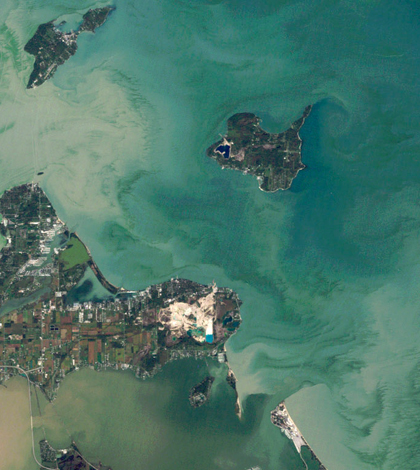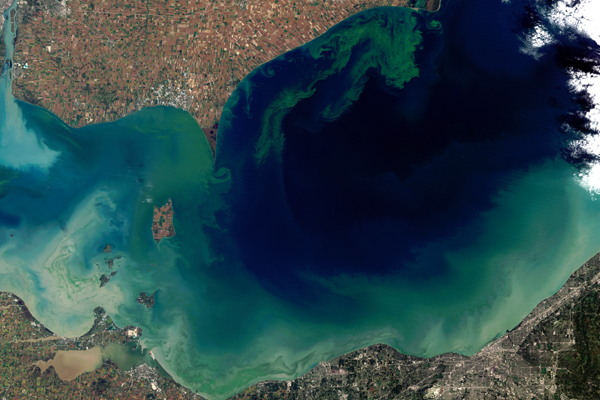What Is Annex 4 Of The Great Lakes Water Quality Agreement?

An algal bloom on Lake Erie in October 2011. (Credit: NASA Earth Observatory / Public Domain)
The 2012 Great Lakes Water Quality Agreement is a massive binational commitment between the United States and Canada to improve conditions in the Great Lakes. Clearly, a big concern in the basin nowadays is the health of Lake Erie and what can be done to bring it back from its present-day difficulties with algae. This goal relies in large part on the fourth annex of the agreement, which sounds a little mysterious. So we’re answering the question: What is Annex 4?
In a nutshell, Annex 4 is the part of the agreement that deals with nutrients and how the two nations are going to move ahead with actions that can better manage the entry of things like phosphorus into the Great Lakes. If other nutrients emerge as important for the lakes’ health in the future, the annex also applies.
The key commitments made by the two nations regarding nutrients are laid out in Annex 4. They include developing binational substance objectives for phosphorus concentrations, loading targets and loading allocations for Lake Erie by 2016. Two years after that, the annex sets a goal to develop phosphorus reduction strategies and action plans to meet phosphorus concentration and loading targets. Other commitments deal with implementing reduction programs, identifying priority watersheds for treatment and sharing research findings.
Another good question now, four years after the agreement was reached, is how are things coming along for achieving the goals set for 2016? A recent webinar and media briefing, hosted by Ohio Sea Grant on July 7, 2016, revealed some of the most recent developments in fulfilling Annex 4. The briefing covered a broad range of Lake Erie issues, including tributary loading and phosphorus cycling research as well as the Lake Erie algal bloom forecast for 2016.
Jeff Reutter, former director of the Ohio Sea Grant and Ohio State University’s Stone Laboratory, now serves as the U.S. Co-Chair of the Objectives and Loadings Task Team for Annex 4. He discussed some of the progress that has been made during his portion of the briefing.
“Our charge was to address harmful algal blooms (western basin), hypoxia (central basin), or the dead zone, and excessive growths of cladophora in the eastern basin,” said Reutter, of a task team that was formed in fall 2013. “We needed to come up with science-based targets that would address those problems. We needed to put together a monitoring program that would allow us to track progress toward achieving our targets. And then what we’re working on right now is the domestic action plan — what actions are we going to take to allow us to achieve those targets?”

An algal bloom on Lake Erie in October 2011. (Credit: NASA Earth Observatory / Public Domain)
Figuring those things out took lots of meetings of the 25-member, binational task team. Members moved forward considering loading targets, necessary monitoring and reporting, among other things, with the understanding that whatever they recommended would have to be possible and acceptable to society. This notion to the common good reflected how the team operated: by consensus. If a member had an objection, that was resolved before moving on to other issues.
Along with this team, a committee of modelers was formed to put changing Lake Erie conditions through their paces. These, in large part, informed the targets that the task team would ultimately recommend.
“We wanted to be sure that we would move forward with an adaptive management approach. Both governments agreed to that and we put together our program,” said Reutter. “The monitoring that we’re recommending for this adaptive management approach is on the tributaries that feed into the lake. We need to know the total load coming in from that tributary, seasonally and annually, but also the flow-weighted mean concentration.”
As part of the approach, the task team also recommends that the models used should be re-run annually as well as refined with new data and findings over time. Members also argue for a review every five years to re-assess research and findings from each of the preceding years.
This is so that targets can be adjusted as needed and the right questions can be posed at the time. “Are we going to be satisfied with a 40 percent reduction?” said Reutter. “Is that still an appropriate target (in the future)?”
The reduction target equates to a spring-load (March 1 through July 31) drop of about 860 tons of total phosphorus and 186 tons of dissolved reactive phosphorus than the lake received in 2008, a year that served as a baseline. If reduction efforts had been in place to achieve those figures over the last 14 years, Reutter says that Lake Erie would have only seen blooms as bad as 2012 twice.
Fourteen tributaries were identified as priority streams for monitoring total phosphorus, dissolved reactive phosphorus and flow-weighted mean concentration to help mitigate algal blooms and hypoxia. Notable tributaries on the list include the Maumee River, which contributed 3,812 tons, and the Sandusky River, which added 1,105 tons to the lake in 2008. The Cuyahoga River also made the list.
“For the tributaries (11 of 14), they’re either a large load or they’re a tributary where we can see a small bloom right at the mouth of that particular tributary,” said Reutter. The other three include Leamington and Toussaint Creeks, which have minor blooms, and the Detroit River, which poses a large challenge because it flows into Lake Erie via five different streams and is very complex to model.
The task team’s final report on recommended phosphorus loading targets for Lake Erie was submitted in May 2015.
Top image: An algal bloom on Lake Erie in October 2011. (Credit: NASA Earth Observatory / Public Domain)





0 comments